Antitrust Policy Quiz 3
1/43
There's no tags or description
Looks like no tags are added yet.
Name | Mastery | Learn | Test | Matching | Spaced |
|---|
No study sessions yet.
44 Terms
Vertical Control
Downstream firms are the customers of the upstream firms.
Types of vertical control
-choice of price is endogenous
-price discrimination (both up and downstream)
-mergers
-entry
Why don’t manufacturers engage in direct marketing
-increasing returns to distribution due to shopping needs/travel costs
-choice of variety
-demand for service
-integration of complementary products
-different geographical markets
Responsibilities of the downstream firm
determination of final price
promotional effort
placement of product on store shelves
promotion and placement of competing products
technological inputs
Downstream firms’ actions can effect the upstream firm
vertically integrated profit
meximum industry or aggregate profit
Types of Vertical Restraints
Exclusive territory-dealer/ distributor/ retailer is
assigned a (usually geographic) territory by the
manufacturer/ upstream firm and given monopoly rights to
sell in that area
Exclusive dealing-a dealer/ distributor/ retailer is not
allowed to carry the brands of a competing upstream firm.
Full-line forcing-a dealer is committed to sell all the
varieties of the manufacturer’s products rather than a
limited selection. (i.e., the upstream firm ties all its
products to sell to the downstream firm).
Resale Price Maintenance-dealer commits to a retail
price or a range of retail prices for the product. This can
take the form of either minimum resale price maintenance
or maximum resale price maintenance. Equivalently, firms
can engage in quantity forcing or quantity rationing.
Contractual arrangements-pstream and downstream
firms write contracts to provide greater flexibility in the
transfer of the product. Profit sharing and revenue sharing
are the most common, which we’ll see soon. Also,
franchising arrangements.
Typical outline of vertical control
1) Basic Framework
2) Externalitites between downstream and upstream firms (max resale price maintenance, quantity forcing, contractual arrangements, full-line forcing)
3) Downstream Moral Hazard or Externalities from INtraband competition (exclusive territorities, minimum rpm, quantity rationing)
Interbrand comp (exclusive dealing or possibly full-line forcing)

Basic framework
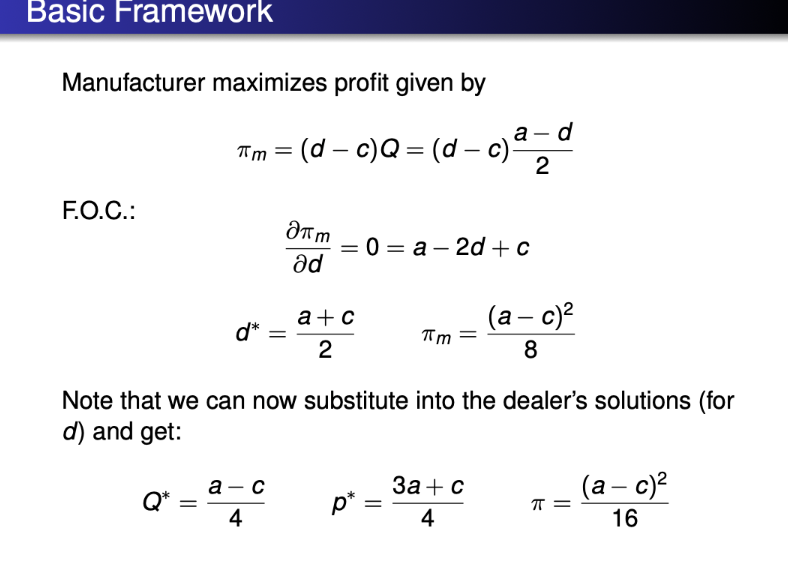
Externalities
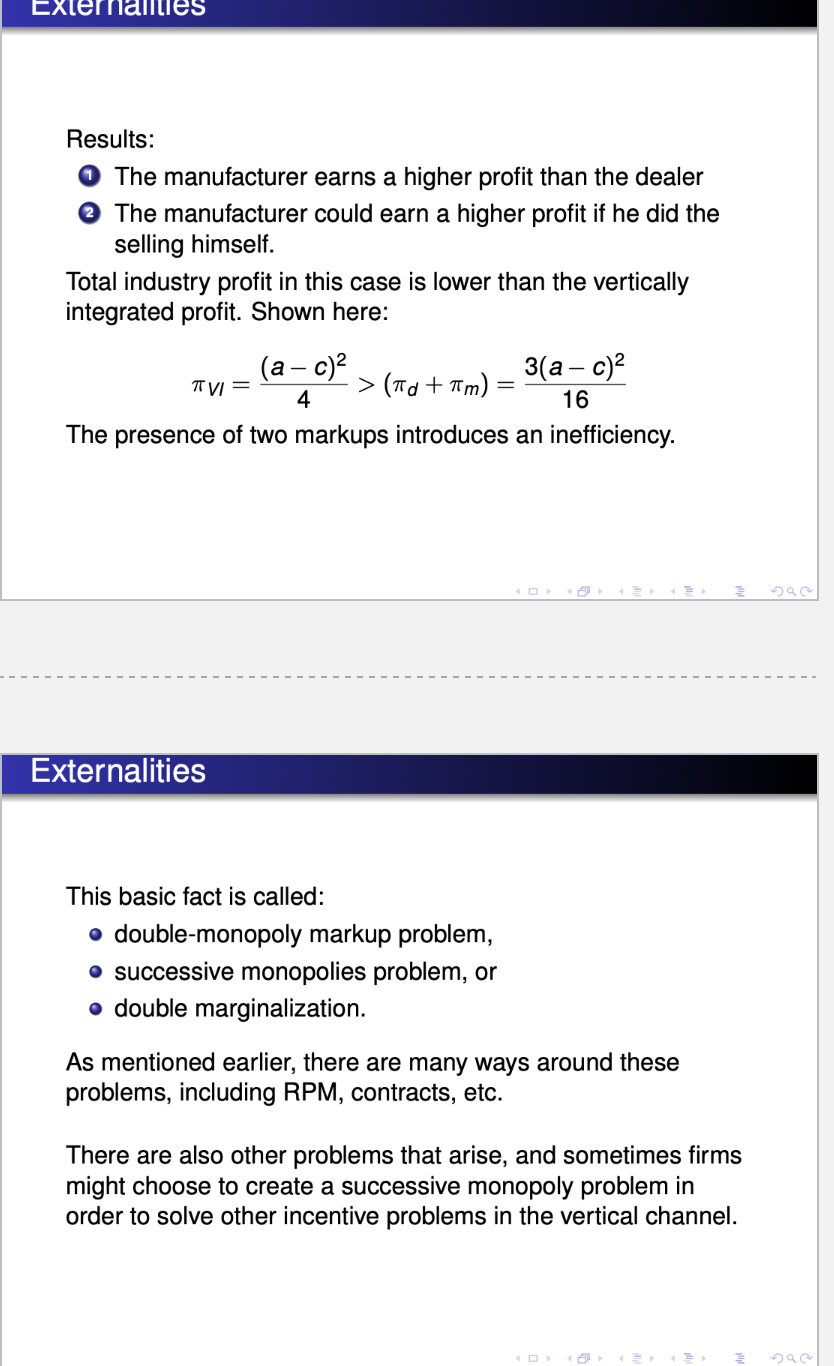
double marginalization
doubke markup
can avoid with rpm contracts and other techniques
Maximum Resale Price Maintenance/Quantity Forcing
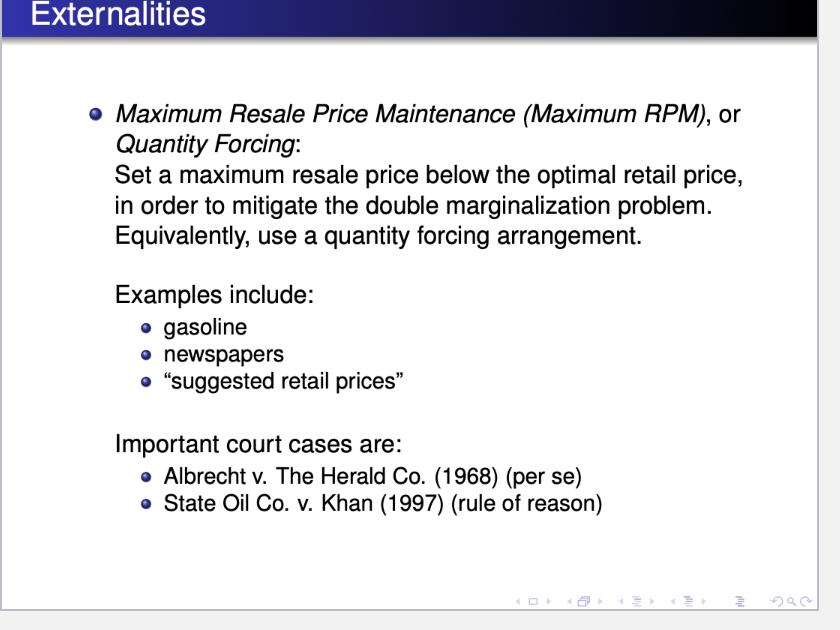
Contractual Arrangements
lots of things, lease the good to downstream firm, pergaps use profit sharing contracts
Profit-sharing or revenue-sharing contracts
like a two-part tariff. Instead of charging linear prices, the manufacturer requires a lump-sum transfer as well as a per-unit charge
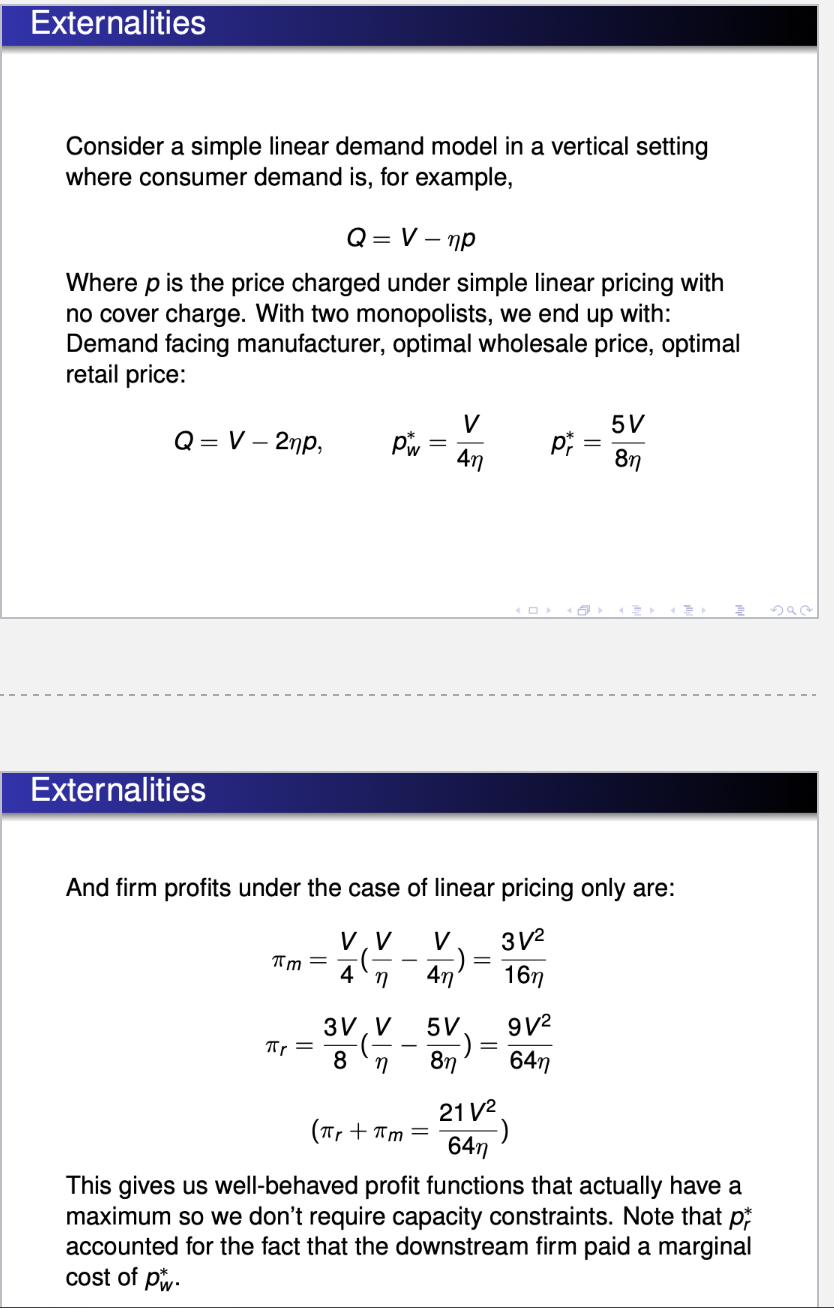
Externalities
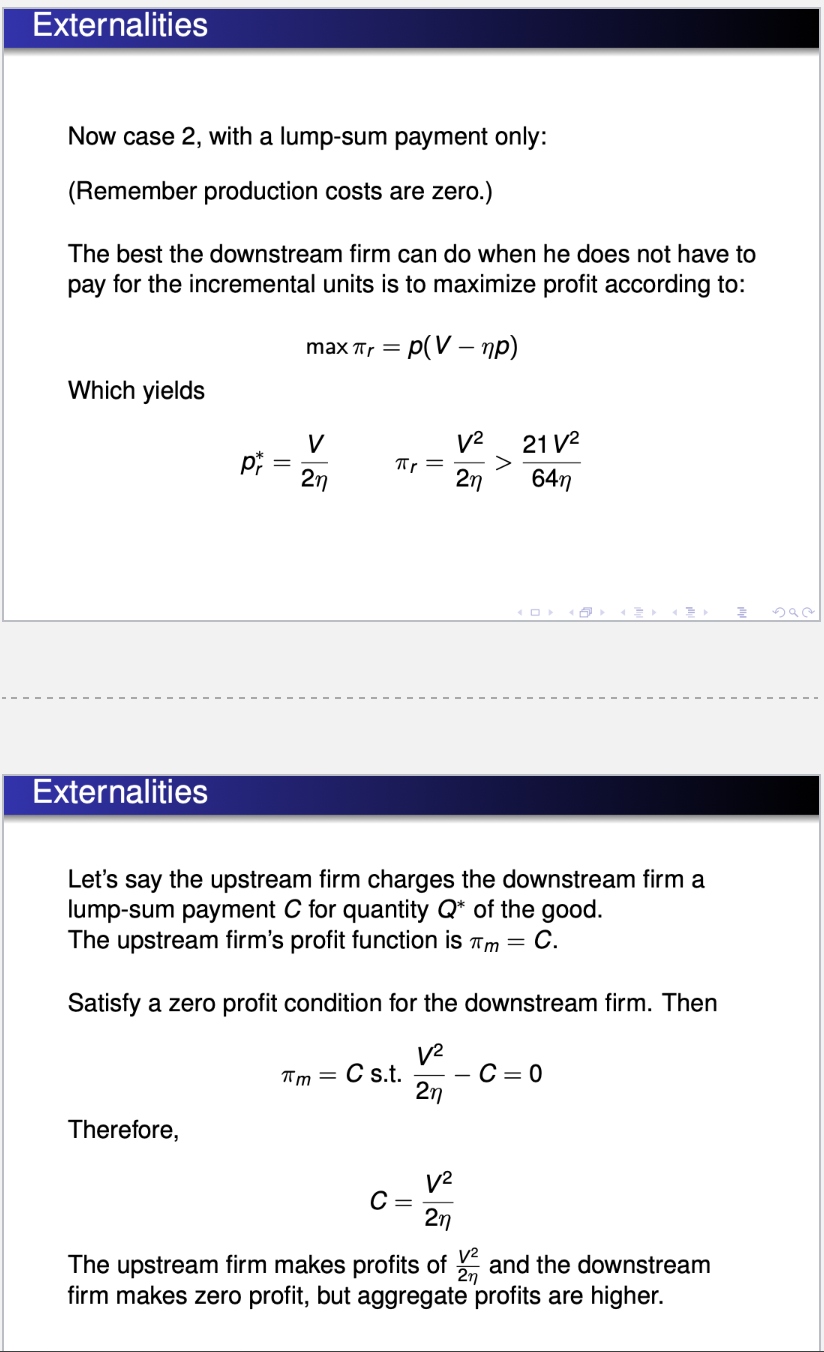
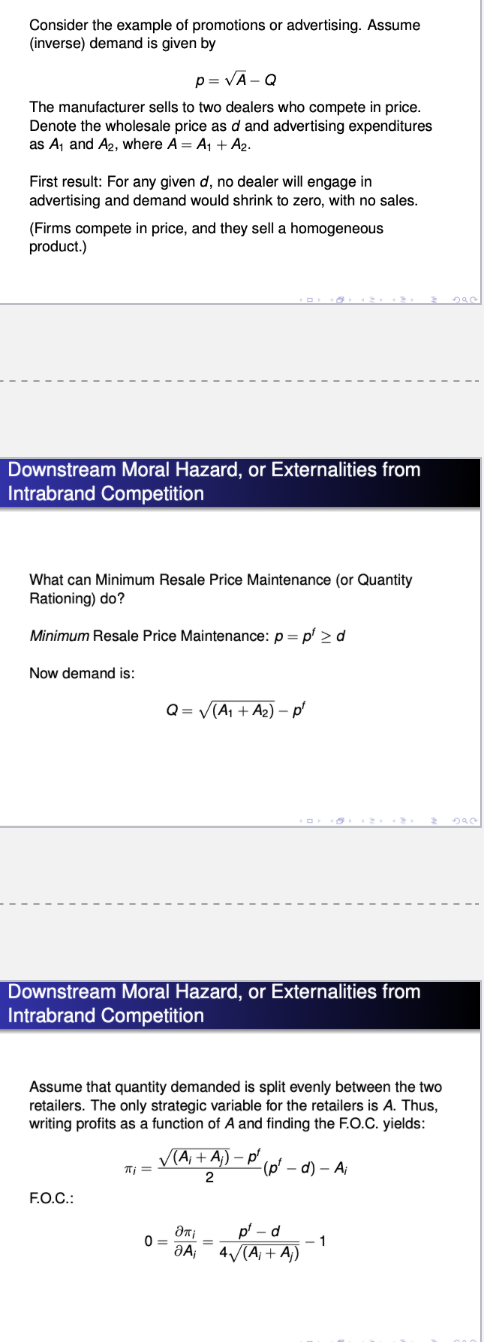
Downstream Moral Hazard
See notes for this one
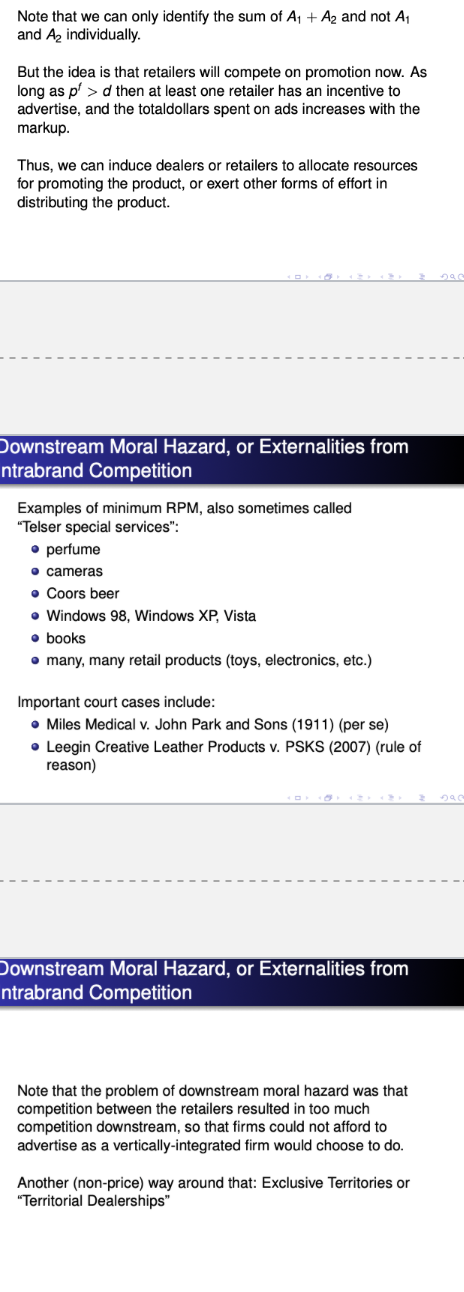
Interbrand Competition
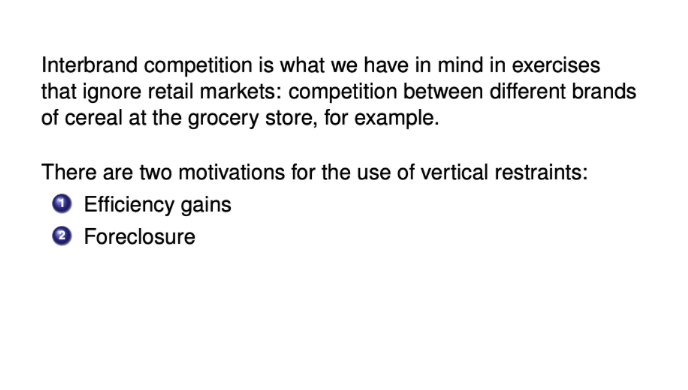
Legal Issues
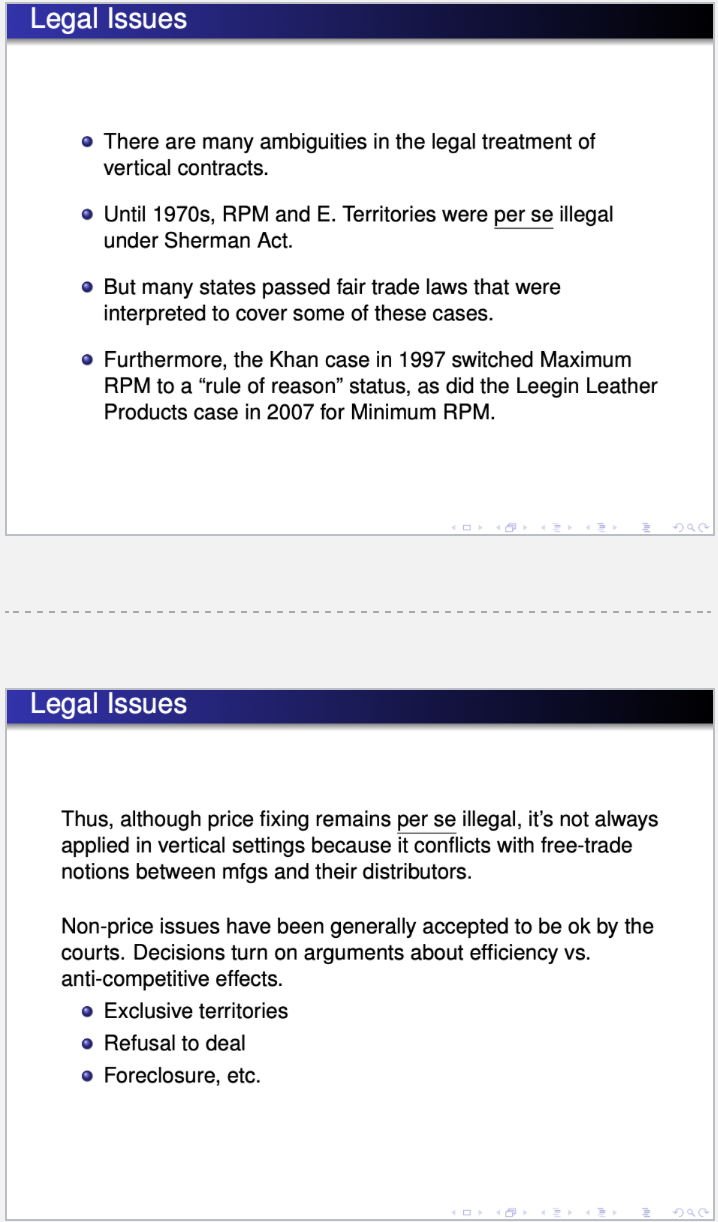
Vertical restrains
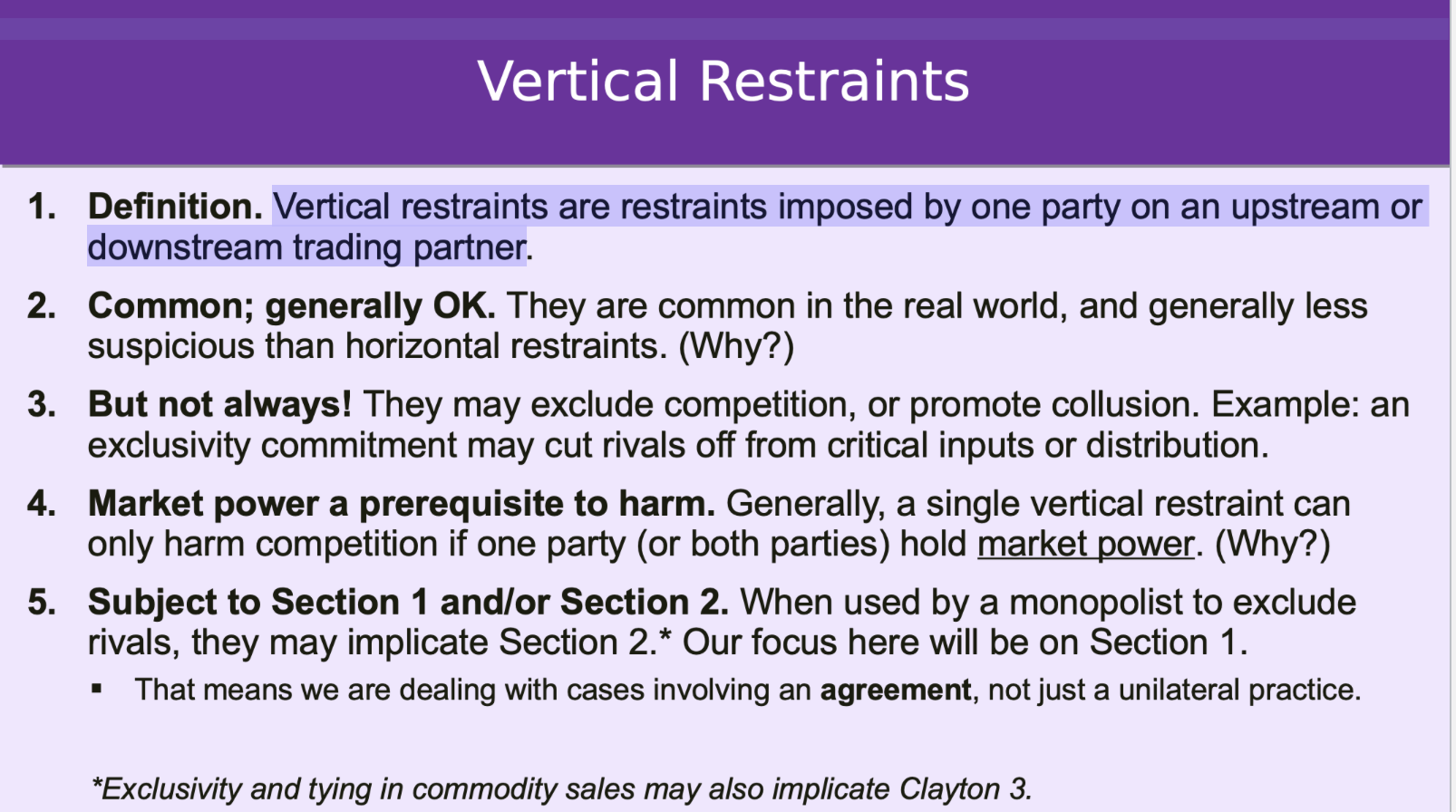
Intrabrand Restraints
Imposed by a manufacturer on its own output
-limits on who can sell it, where, at what price
-does not restrain anyone’s ability to carry other suppliers’ output
Interbrand restraint
affects trading partners’ ability/incentive to carry other brands
-exclusivity, tying
GTE Sylvania
Intrabrand and Interbrand interaction
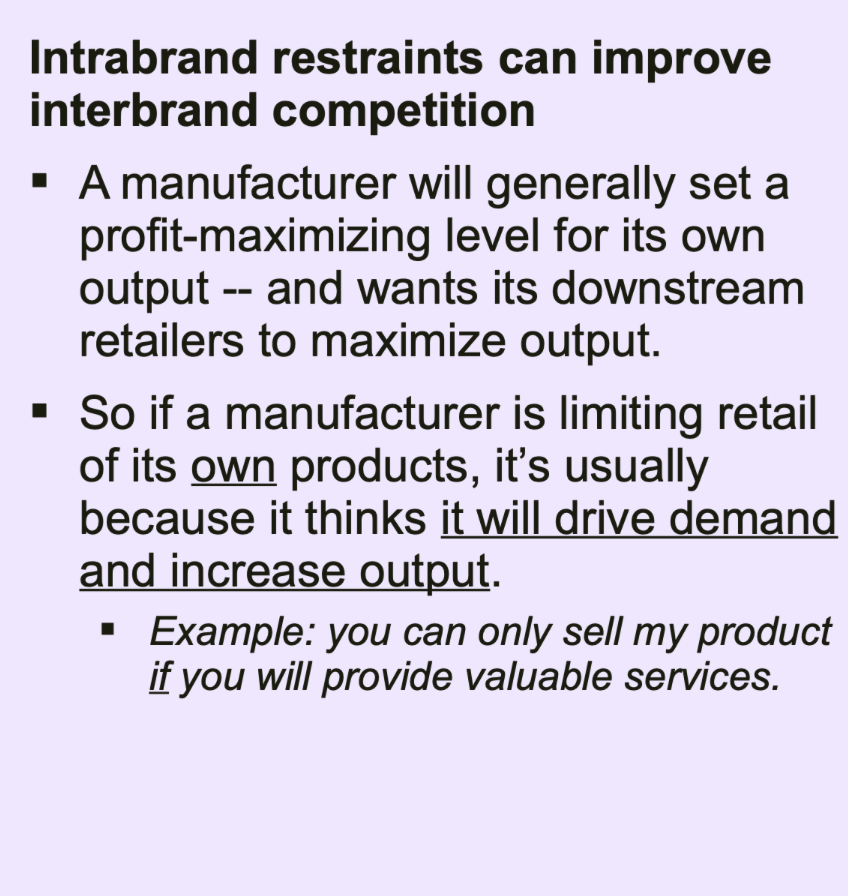
Territorial restrictions
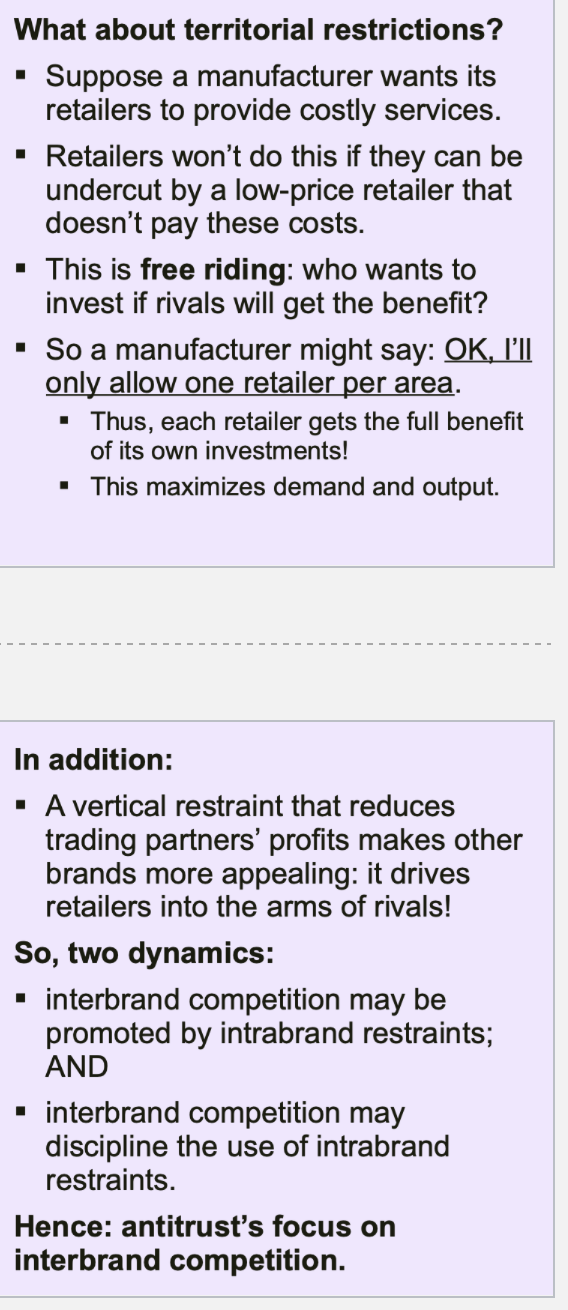
US v Schwinn
-nonprice restraints
-schwinn made bikes and was losing share so changed distribution plan
1) Smaller set of distributors
2) Each had an exclusive territory
3) Required to give at least equal prominence to Schwinn bikes as to competitors
4) Some sales trhough consignment others through resale
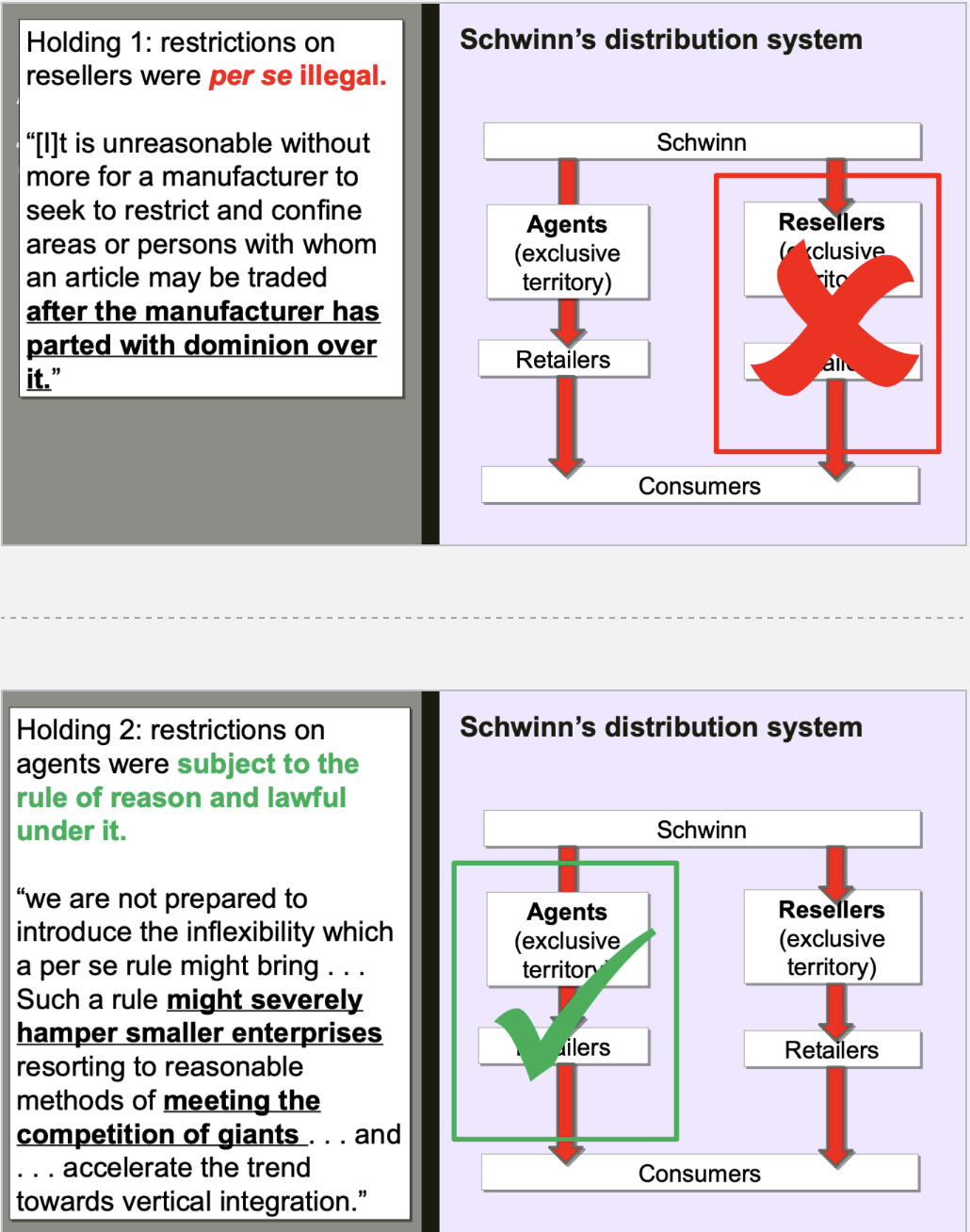
Continental TV v GTE Sylvania
1. GTE Sylvania made TVs: national
share 1-2%.
2. It phased out its wholesalers and
started selling to a limited
number of retailers in each area.
3. “An acknowledged purpose of the
change was to decrease the
number of competing Sylvania
retailers in the hope of attracting
the more aggressive and
competent retailers thought
necessary to the improvement of
the company’s market position.”
4. A terminated franchisee sued.
At trial:
Sylvania asked for rule of reason
jury instruction; didn’t get it; lost.
Supreme Ct:
“Interbrand competition is . . . among
the manufacturers of . . . television
sets in this case and is the primary
concern of antitrust law.”
“Vertical restrictions promote
interbrand competition by allowing
the manufacturer to achieve certain
efficiencies in . . . distribution[.]”
R of R for all nonprice vertical
restraints.
SCHWINN OVERRULED
![<p>1. GTE Sylvania made TVs: national<br>share 1-2%.<br>2. It phased out its wholesalers and<br>started selling to a limited<br>number of retailers in each area.<br>3. “An acknowledged purpose of the<br>change was to decrease the<br>number of competing Sylvania<br>retailers in the hope of attracting<br>the more aggressive and<br>competent retailers thought<br>necessary to the improvement of<br>the company’s market position.”<br>4. A terminated franchisee sued.</p><p><br>At trial:<br> Sylvania asked for rule of reason<br>jury instruction; didn’t get it; lost.<br>Supreme Ct:<br> “Interbrand competition is . . . among<br>the manufacturers of . . . television<br>sets in this case and is the primary<br>concern of antitrust law.”<br> “Vertical restrictions promote<br>interbrand competition by allowing<br>the manufacturer to achieve certain<br>efficiencies in . . . distribution[.]”<br> R of R for all nonprice vertical<br>restraints.<br>SCHWINN OVERRULED</p><p><br></p>](https://knowt-user-attachments.s3.amazonaws.com/1ff77d98-b0c4-4dbd-bc06-8ae933ee1e53.jpeg)
Intrabrand Price restraints: Resale Price Maintenance
Court held:
1. Dealer freedom is an important
value in antitrust analysis.
“If there be an advantage to the
manufacturer in the maintenance of
fixed retail prices, the question
remains whether it is one which he is
entitled to secure by agreements
restricting the freedom of trade on
the part of dealers who own what
they sell.”
Court held:
2. Manufacturer RPM and a dealer
price-fixing cartel are equivalent
– and so must be treated alike.
“Dr. Miles can fare no better with its
plan of identical contracts than could
the dealers themselves if they
formed a combination and
endeavored to establish the same
restrictions.”
3. And a dealer price-fixing cartel
would be super illegal.
“[A]greements or combinations
between dealers, having for their sole
purpose the destruction of competition
and the fixing of prices, are injurious to
the public interest and void.”
= therefore RPM must be per se
illegal.
How can this be per se illegal?
1. Dr Miles could do this lawfully if
its retailers were agents.
“[B]y a slight change in the form of the
contract the plaintiff can accomplish
the result in a way that would be
beyond successful attack. If it should
make the retail dealers [agents of Dr.
Miles], and retain the title until the goods
left their hands, I cannot conceive that
even the present enthusiasm for
regulating the prices to be charged by
other people would deny that the owner
was acting within his rights.”
2. Presumption against interfering
with business operations.
“I think that at least it is safe to say
that the most enlightened judicial
policy is to let people manage their
own business in their own way,
unless the ground for interference is
very clear.”
3. Shouldn’t interfere: intrabrand
competition isn’t important.
“[W]e greatly exaggerate the
value . . . of competition in
production or distribution . . . as
fixing a fair price. . . . As soon as the
price of something that we want goes
above the point at which we are willing
to give up other things to have that, we
cease to buy it and buy something else.
. . . The Dr. Miles Medical Company
knows better than we do what will
enable it to do the best business.”
4. And why protect dealers’ rights to
violate contracts and undermine
sales of Dr Miles’s own product?
“I cannot believe that in the long run the
public will profit by this court permitting
knaves to cut reasonable prices for
some ulterior purpose of their own,
and thus to impair, if not to destroy, the
production and sale of articles which it
is assumed to be desirable that the
public should be able to get.
![<p>Court held:<br>1. Dealer freedom is an important<br>value in antitrust analysis.<br>“If there be an advantage to the<br>manufacturer in the maintenance of<br>fixed retail prices, the question<br>remains whether it is one which he is<br>entitled to secure by agreements<br>restricting the freedom of trade on<br>the part of dealers who own what<br>they sell.”</p><p>Court held:<br>2. Manufacturer RPM and a dealer<br>price-fixing cartel are equivalent<br>– and so must be treated alike.<br>“Dr. Miles can fare no better with its<br>plan of identical contracts than could<br>the dealers themselves if they<br>formed a combination and<br>endeavored to establish the same<br>restrictions.”</p><p>3. And a dealer price-fixing cartel<br>would be super illegal.<br>“[A]greements or combinations<br>between dealers, having for their sole<br>purpose the destruction of competition<br>and the fixing of prices, are injurious to<br>the public interest and void.”<br>= therefore RPM must be per se<br>illegal.</p><p></p><p>How can this be per se illegal?<br>1. Dr Miles could do this lawfully if<br>its retailers were agents.<br>“[B]y a slight change in the form of the<br>contract the plaintiff can accomplish<br>the result in a way that would be<br>beyond successful attack. If it should<br>make the retail dealers [agents of Dr.<br>Miles], and retain the title until the goods<br>left their hands, I cannot conceive that<br>even the present enthusiasm for<br>regulating the prices to be charged by<br>other people would deny that the owner<br>was acting within his rights.”</p><p>2. Presumption against interfering<br>with business operations.<br>“I think that at least it is safe to say<br>that the most enlightened judicial<br>policy is to let people manage their<br>own business in their own way,<br>unless the ground for interference is<br>very clear.”</p><p>3. Shouldn’t interfere: intrabrand<br>competition isn’t important.<br>“[W]e greatly exaggerate the<br>value . . . of competition in<br>production or distribution . . . as<br>fixing a fair price. . . . As soon as the<br>price of something that we want goes<br>above the point at which we are willing<br>to give up other things to have that, we<br>cease to buy it and buy something else.<br>. . . The Dr. Miles Medical Company<br>knows better than we do what will<br>enable it to do the best business.”</p><p>4. And why protect dealers’ rights to<br>violate contracts and undermine<br>sales of Dr Miles’s own product?<br>“I cannot believe that in the long run the<br>public will profit by this court permitting<br>knaves to cut reasonable prices for<br>some ulterior purpose of their own,<br>and thus to impair, if not to destroy, the<br>production and sale of articles which it<br>is assumed to be desirable that the<br>public should be able to get.</p>](https://knowt-user-attachments.s3.amazonaws.com/f9ce1efc-4cb2-4b36-8850-8280a8b3160d.jpeg)
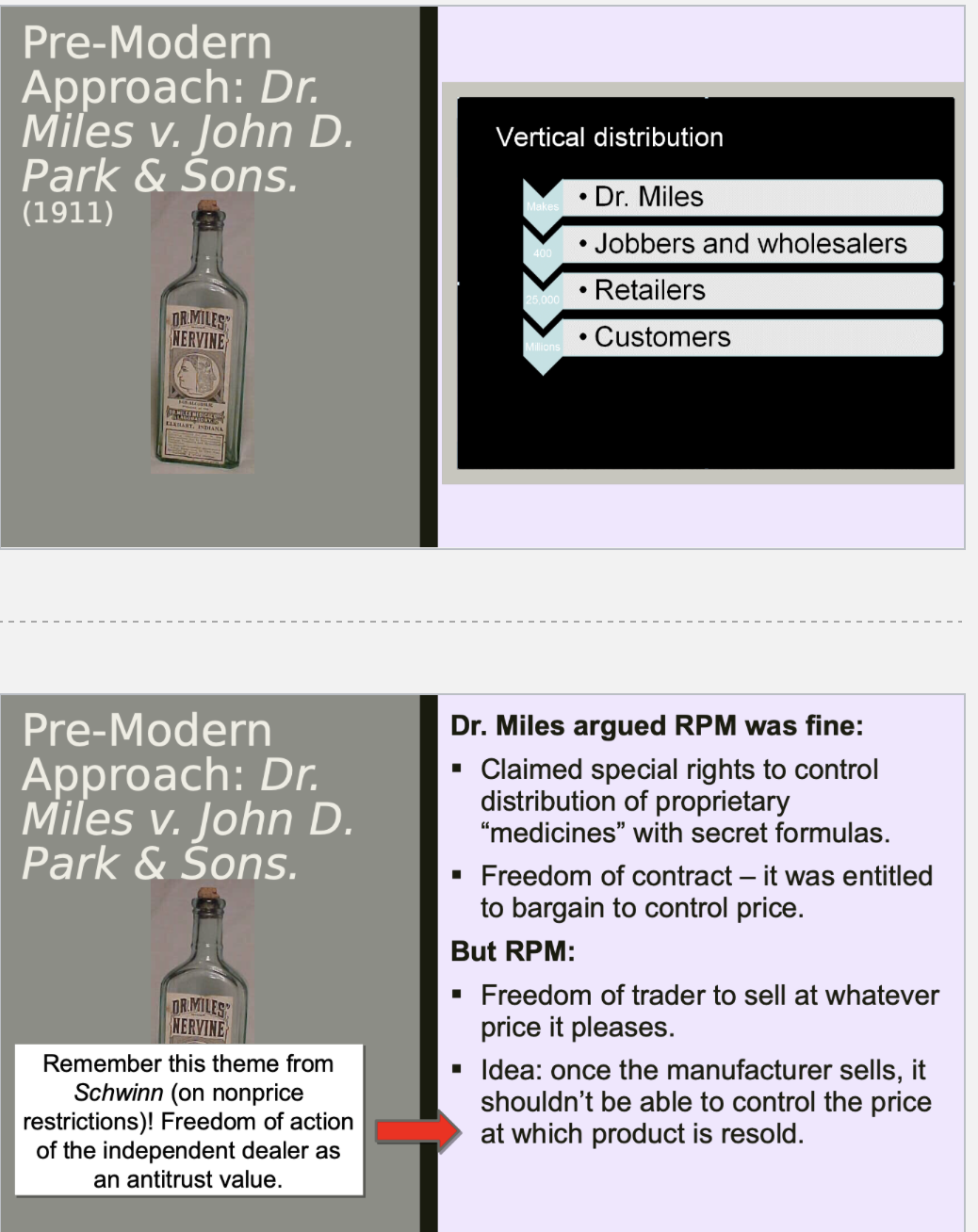
Dr Miles Medical Co v John D Park and Sons (1911)
Albrecht
What happened in Albrecht?
1. Herald Co. published the “Globe-
Democrat,” a newspaper with a
weird name.
2. It gave its delivery carriers
exclusive territories, but it was
worried about retailer overcharging,
so it set maximum resale prices.
3. Albrecht overcharged so Herald
hired another carrier to sell at the
lower price.
4. Albrecht sued - and won! Court
held: maximum RPM is per se
illegal!
Why is this “illegal price fixing”?
1. “Maximum prices may be fixed too
low for the dealer to furnish
[valuable] services[.]
2. “Maximum price fixing may channel
distribution through a few large or
specifically advantaged dealers.”
3. “[I]f the actual price charged under a
maximum price scheme is nearly
always the fixed maximum price . . .
the scheme [resembles minimum
RPM].”
Harlan dissent
1. Not everything is per se illegal!
“It has long been recognized that one of
the objectives of the Sherman Act was
to preserve, for social rather than
economic reasons, a high degree of
independence, multiplicity, and variety
in the economic system.”
“Recognition of this objective does not,
however, require this Court to hold
that every commercial act that
fetters the freedom of some trader is
a proper subject for a per se rule in
the sense that it has no adequate
provable justification.”
2. This is Herald Co’s unilateral
distribution policy, not an
agreement with the other carriers.
“A firm is not ‘combining’ to fix its own
prices or territory simply because it
hires outside accountants, market
analysts, advertisers by telephone or
otherwise, or delivery boys.
3. And it’s not been shown to be
harmful here!
“The question in this case is not
whether dictation of maximum prices is
ever illegal, but whether it is always
illegal. . . . The best the Court can do is
to list certain unfortunate
consequences that maximum price
dictation might have in other cases but
was not shown to have here.
State Oil Co v Khan
Although the rule of Albrecht has been
in effect for some time, the inquiry we
must undertake requires considering
the effect of the antitrust laws upon
vertical distributional restraints in the
American economy today. . . . [T]here
has not been another case since
Albrecht in which this Court has
confronted an unadulterated vertical,
maximum-price-fixing arrangement.
Now that we confront Albrecht directly,
we find its conceptual foundations
gravely weakened.”
ALBRECHT OVERRULED
Leegin Creative Leather Prods v PSKS (2007)
Leegin made Brighton belts and
suggested resale prices. Kay’s Kloset
discounted them and was terminated.
Bottom line, per Justice Kennedy:
“The Court has abandoned the rule of
per se illegality for other vertical
restraints a manufacturer imposes on its
distributors. Respected economic
analysts, furthermore, conclude that
vertical price restraints can have
procompetitive effects. We now hold that
Dr. Miles should be overruled and that
vertical price restraints are to be
judged by the rule of reason.”
RPM can be procompetitive
“[E]conomics literature is replete with
procompetitive justifications for
[RPM]”
RPM “encourages retailers to invest in
. . . services or promotional efforts
that aid the manufacturer’s position as
against rival manufacturers”
RPM can be anticompetitive
It can facilitate cartels by dealers or
manufacturers
It can be abused by manufacturers or
retailers with market power
Because its competitive effect is not
predictable, and often good, the rule
of reason should govern.
“Vertical agreements establishing
minimum resale prices can have either
procompetitive or anticompetitive
effects, depending upon the
circumstances in which they are formed.
And although the empirical evidence on
the topic is limited, it does not suggest
efficient uses of the agreements are
infrequent or hypothetical.”
DR. MILES OVERRULED
Overruled Dr Miles
This will be too complicated for
courts: the result will be
underenforcement.
“One cannot fairly expect judges and
juries in such cases to apply complex
economic criteria without making a
considerable number of mistakes,
which themselves may impose
serious costs.”
Better to stick with the per se rule
(maybe w modification for RPM in
connection with new entry).
Role of economics in antitrust:
“[E]conomics can, and should, inform
antitrust law. But antitrust law cannot,
and should not, precisely replicate
economists’ (sometimes conflicting)
views. That is because law, unlike
economics, is an administrative
system the effects of which
depend upon the content of rules
and precedents only as they are
applied by judges and juries in
courts and by lawyers advising their
clients.”
Exclusivity
Exclusivity might be the paradigm
vertical interbrand restraint: extracting
an agreement not to deal with
competitors from trading partners.
This can suppress or eliminate
competition under certain
circumstances.
NOTE: softer variations are possible:
agreements that encourage exclusivity
without mandating it (e.g., price
differentials).
Core concern is “foreclosure.”
Cutting off, or limiting, rivals’ access to
competitively important inputs (input
foreclosure), or...
Core concern is “foreclosure.”
Cutting off, or limiting, rivals’ access to
competitively important distribution
(distribution foreclosure)
But not always bad or illegal.
1. Exclusivity is pretty common.
2. Trading partners often make
significant investments in each
other, and may not make
investments if competitors can
benefit from them.
3. And a party may highly value
security of supply from the
knowledge that the trading partner is
not also splitting its attention with
others.
But not always bad or illegal.
1. Examples:
a) A chipmaker might partner exclusively
with a device OEM to develop a new
chip that makes new features possible.
b) A fast food franchisee (always!) agrees
to carry only one brand of fast food.
c) A brand might pay for celebrity
endorsement only if that celebrity will
not also promote a competitor.
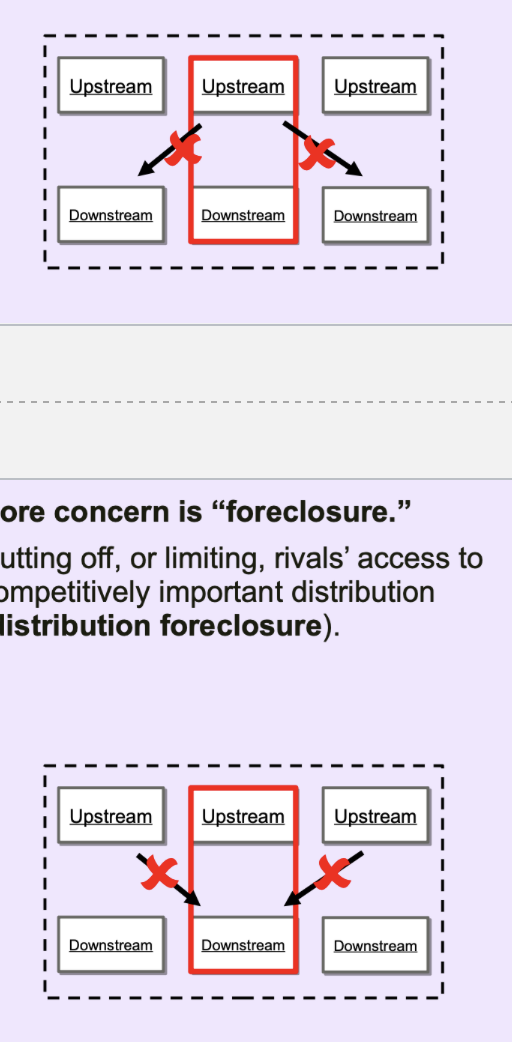
Tampa Electric v Nashville Coal (1961)
The Seminal
Case: Tampa
Electric
1. Tampa Electric operated power
plants. It agreed to buy all its
requirements of coal from Nashville
Coal Co.
2. Nashville was one of 700 coal
suppliers in the area, and the
contract represented ~1% of coal
production available for use in FL.
3. Tampa then spent millions of dollars
preparing to use Nashville’s coal.
4. Shortly before delivery date,
Nashville said: the contract’s an
antitrust violation, we’re not
performing, good luck with
everything, k thanks bye
The Court applied s 3 Clayton Act
(broadly equivalent to s 1 Sherman
Act), and set out what is now a
critical principle:
“In practical application, [exclusive
dealing] does not violate the section
unless the court believes it probable
that performance of the contract will
foreclose competition in a
substantial share of the line of
commerce affected.”= SUBSTANTIAL
FORECLOSURE TEST
= SUBSTANTIAL
FORECLOSURE TEST
PRELIMINARY STEP
“First, the line of commerce, i.e., the
type of goods, wares, or merchandise,
etc., involved must be determined,
where it is in controversy, on the basis
of the facts peculiar to the case. . .
[And] the area of effective competition
in the known line of commerce must be
charted by careful selection of the
market area in which the seller
operates, and to which the purchaser
can practicably turn for supplies”
= MARKET DEFINITION
SUBSTANTIAL FORECLOSURE
Exclusivity must foreclose “a substantial
share” of the market.
“[O]pportunities for other traders” must
be “significantly limited.”
Court must “weigh the probable effect of
the contract on the relevant area of
effective competition, taking into
account the relative strength of the
parties, the proportionate volume of
commerce involved in relation to the
total volume of commerce in the
relevant market area, and the probable
immediate and future effects which pre-
emption of that share of the market
might have on . . . competition[.]”
In other words: in light of all the
facts, is this really likely to harm
competitive conditions?
Note: The earlier Standard
Stations case (1949) had inferred
sufficient harm from exclusive deals
covering just 16% of distribution
capacity (in that case, service
stations for retailing gas). The
Standard Stations Court did not
undertake the kind of careful
analysis signaled in Tampa: so this
raised the bar for plaintiffs.
PPLICATION
“[I]t clearly appears that the
proportionate volume of the total
relevant coal product as to which the
challenged contract pre-empted
competition, less than 1%, is,
conservatively speaking, quite
insubstantial”
What are we really measuring here?
1. Key idea is that not ALL restrictions
of access to inputs or distribution
harm competition.
2. Restriction of access must usually
be such that it raises rivals’ costs
(e.g., insufficient amount, or
insufficient quality, of inputs /
distribution, or facilitating
coordination); AND
3. This impact must be capable of
affecting competitive conditions.
Microsoft (2001) suggested 40-50%
foreclosure share in a Section 1 case.
Roland Machinery v Dresser Industries
. Roland distributed machinery from Dresser.
2. Roland then agreed to distribute for Komatsu
too.
3. Dresser exercised its right to terminate
Roland without cause.
4. Roland sued under Section 3.
5. Issue: could Roland get a preliminary
injunction to prevent Dresser cutting it
off during the litigation?Q: What was the foreclosure
concern here?
A: Distribution foreclosure
of Komatsu: competitive
harm among manufacturers.
Q: What was the foreclosure
concern here?
A: Distribution foreclosure
of Komatsu: competitive
harm among manufacturers.
Court below held:
1. There was an implicit exclusive
agreement between Dresser and Roland.
2. Dresser accounted for 16-17% of
construction equipment in central Ilinois -- all
Dresser sales go through Roland.
3. Komatsu could only enter by persuading a
dealer to carry Komatsu as a second line.
4. Roland might go out of business if cut off.
Granted the injunction; Dresser appealed.
Writing for the Seventh Circuit, Judge Posner
was not happy. Held:
1. No suggestion of agreement.
2. Little reason to think it was anticompetitive.
Preliminary injunction should be
vacated.
The Poze Sez No
FIRST: No agreement, just unilateral action.
“The fact that Dresser was hostile to dealers
who would not live and die by its product . . .
and acted on its hostility by canceling a
dealer who did the thing to which it was hostile,
does not establish an agreement[.]”
“Assume that Dresser made clear to Roland
and its other dealers that it wanted only
exclusive dealers[.] . . . The mere
announcement of such a policy, and the
carrying out of it by canceling Roland or any
other noncomplying dealer, would not
establish an agreement.”
ECOND: Doesn’t seem unlawful.
Modern law does not judge exclusivity under
the “simple and strict” test of earlier cases.
• “Although the Supreme Court has not
decided an exclusive-dealing case in many
years, it now appears most unlikely that
such agreements, whether challenged
under section 3 of the Clayton Act or
section 1 of the Sherman Act, will be
judged by the simple and strict test
of Standard Stations.”
SECOND: Doesn’t seem unlawful.
“The exclusion of one or even several
competitors, for a short time or even a long
time, is not ipso facto unreasonable. . . . a
plaintiff must prove two things to show that an
exclusive-dealing agreement is unreasonable.
First, he must prove that it is likely to keep at
least one significant competitor of the
defendant from doing business in a relevant
market. If there is no exclusion of a significant
competitor, the agreement cannot possibly
harm competition. Second, he must prove
that the probable . . . effect of the exclusion
will be to raise prices above (and therefore
reduce output below) the competitive level,
or otherwise injure competition[
“Komatsu cannot be kept out of the central
Illinois market even if every manufacturer of
construction equipment prefers exclusive
dealers . . . . Komatsu is the second largest
manufacturer of construction equipment in
the world. . . . Since dealership agreements in
this industry are terminable by either party on
short notice, Komatsu, to obtain its own
exclusive dealer in some area, has only to
offer a better deal to some other
manufacturer's dealer in the area.”
= Komatsu can compete FOR exclusive
relationships
THIRD: Exclusivity has benefits!
May lead to better promotional efforts and
services.
• “If . . . exclusive dealing leads dealers to
promote each manufacturer’s brand more
vigorously . . . the quality-adjusted price to
the consumer . . . ma
May align incentives so dealers have skin in
the game of promoting the manufacturer’s
brand.
• “A dealer who expresses his willingness to
carry only one manufacturer’s brand of a
particular product . . . doesn’t have divided
loyalties. . . . [I]f Roland failed to promote
Dresser vigorously, it would have Komatsu
to fall back on—but Dresser might suffer a
drastic decline in the central Illinois
market[.]”
y be lower with
exclusive dealing
THIRD: Exclusivity has benefits!
May help protect against dealer free riding.
• “Exclusive dealing may also enable a
manufacturer to prevent dealers from taking
a free ride on his efforts (for example, efforts
in the form of national advertising) to
promote his brand. The dealer who carried
competing brands as well might switch
customers to a lower-priced substitute on
which he got a higher margin.”
than without[.]”
Section 1 Sherman vs Section 3 Clayton
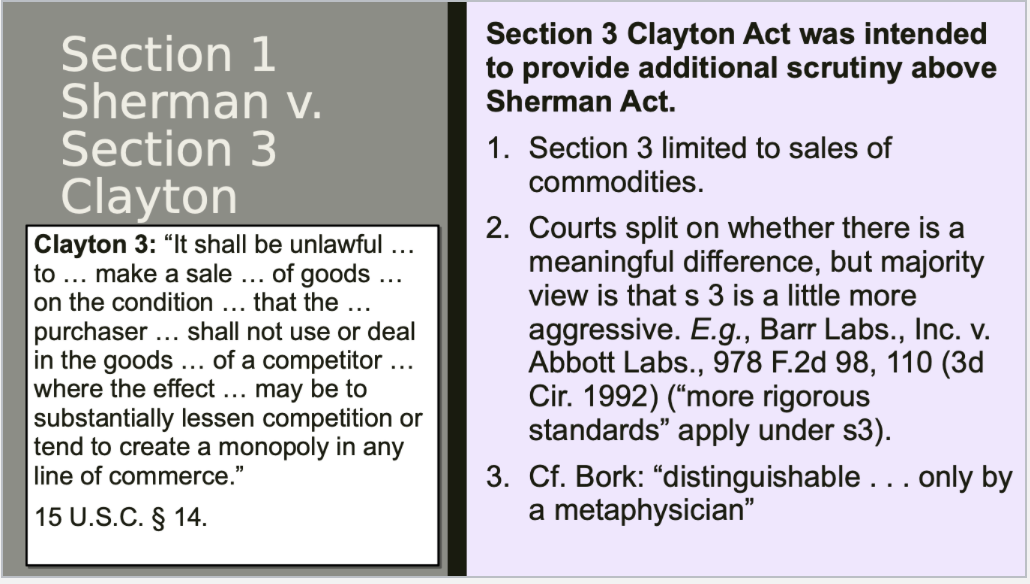
Tying
Tying is the practice of selling one
thing (the TYING product/service)
only condition that the purchaser
buy something else from you as well
(the TIED product/service)
Core competitive concern: use of
market power to generate customer
foreclosure in a second market.
1. A seller might use market power in
the tying product / service to make
customers purchase the tied product
/ service.
2. Doing so might deprive rivals of
scale efficiencies and make them
less able to compete in the tied
market.
3. The result may be more market
power in the tied market
But two important qualifications.
1. First: there are often very good
reasons to sell things together.
a. No-one sells infinitely subdivided
products. (Is it tying to sell a hot dog?)
b. And there are often huge efficiencies in
doing so.
2. Second: under some
circumstances you cannot create
market power with a tie. (The
“Single Monopoly Profit
Theorem.”)
Single Monopoly Profit
You normally cannot create
additional profit by tying to a strict
complement that is consumed in
fixed proportions. Implication: if you
are finding it profitable to do so, it’s
probably because of efficiencies.
1. Example: if demand is only for “1
cup + 1 saucer” pairs, and if I am
already a cup monopolist, I can
make no more money by tying cups
to saucers than I could make by
charging for my cups alone.
Pretty limited zone of application.
But the SMP does not apply:
1. If complements are used in
variable proportions. Shifting
margin to the one used more heavily
by inelastic customers is a form of
price discrimination: extracts more
profit from intensive users.
2. If complements are not strict. If
there is demand for one good
without the other, depriving rivals of
scale might augment market power.
3. If one market is a path to the
other. Requiring “two level entry” or
eliminating an entry path may
entrench tying market power.
Where can you challenge tying
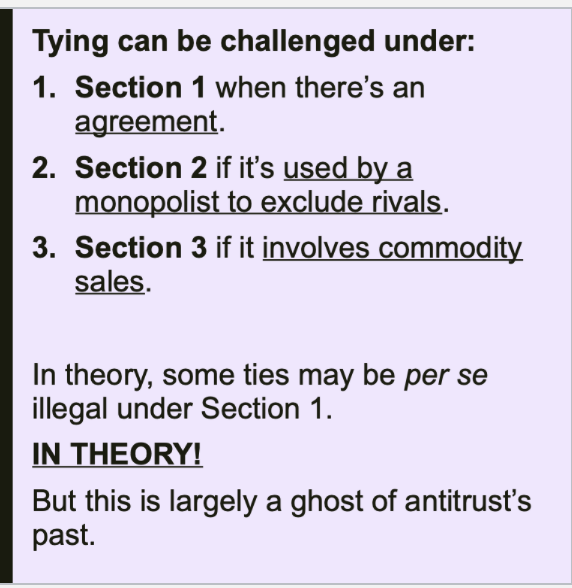
Requirements for per se tying
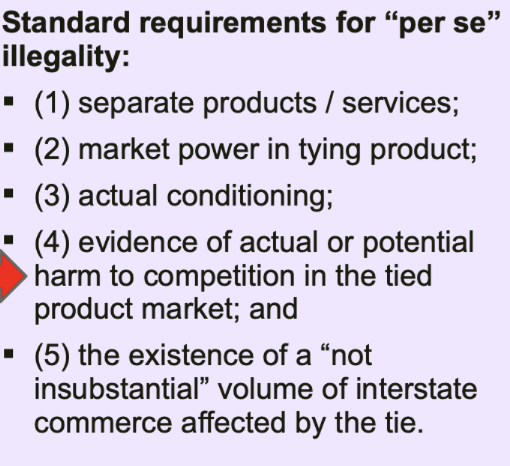
Jefferson Parish Hospital District 2 (1984)
East Jefferson hospital: if we treat
you, you have to get anesthesia
services from Roux and Associates.
Challenged as a § 1 tie.
Justice Stevens for the Court:
It is far too late in the history of
our antitrust jurisprudence to
question the proposition that
certain tying arrangements pose
an unacceptable risk of stifling
competition and therefore are
unreasonable “per se.”
Not the clearest decision
Defended a limited per se rule.
Test:
1. Separate products (“demand for .
. . anesthesiological services
separate from hospital
services”).
2. Tying market power (“control
over the tying product”).
3. Actual conditioning (“forcing”).
4. Evidence of harm to competition
(“substantial potential for impact
on competition”).
5. Volume of interstate commerce
(“substantial volume”).
Jefferson Parish:
majority opinion
O’Connor C’mon, enough already! “The time
has come to abandon the ‘per se’
label and refocus . . . on the adverse
economic effects, and the potential
economic benefits, [of a tie].”
“First, the seller must have power in the
tying product market.”
“Second, there must be a substantial
threat that the tying seller will acquire
market power in the tied-product
market.”
“Third, there must be a coherent
economic basis for treating the tying
and tied products as distinct.”
Fourth, conIn this case, no separate products.
1. Demand is always for a hospital-
services-plus-anesthesia package,
never anesthesia alone.
2. The “tying . . . cannot increase the
seller’s already absolute power over
the volume of production of the tied
product.”
3. And procompetitive benefits!
a. More efficient logistics.
b. Better quality monitoring.
c. Allows hospital to ensure
compatibility w standards.
d. Exclusivity is common in
hospitals.How is this different from
Justice Stevens’
separateness test?
r “economic benefits.
Most favored nation
An MFN (“most favored nation”)
agreement entitles the beneficiary to
treatment at least as favorable as
others are getting.
1. Example: MFN pricing means I, a
beneficiary buyer, get the best price
at which you sell to anyone.
2. Sounds great, right? And it can be.
3. Can help push prices down in a
world of imperfect information:
makes it easier to figure out what
low prices a supplier can really
offer.
And can help buyers fight efforts at
price discrimination!
But the dark side of an MFN is that it is
also a promise not to offer other trading
partners a better deal.
A business with market power might
use an MFN to prevent a trading
partner giving deals to encourage
competitive entry.Entrant?
Entrant?Key Input
Key InputMonopolist
Monopolist
But the dark side of an MFN is that it is
also a promise not to offer other trading
partners a better deal.
Participants in a cartel or tacit
collusion might use an MFN to
commit not to discount.
How do MFNs penalize discounting?
But the dark side of an MFN is that it is
also a promise not to offer other trading
partners a better deal.
An MFN-plus is a promise to get
better treatment by some margin.
This is a surcharge on dealing with
rivals and VERY suspicious.
E.g., “You commit to give me a price
at least 10% better than any rival is
getting.”
Section 2 of the Sherman Act
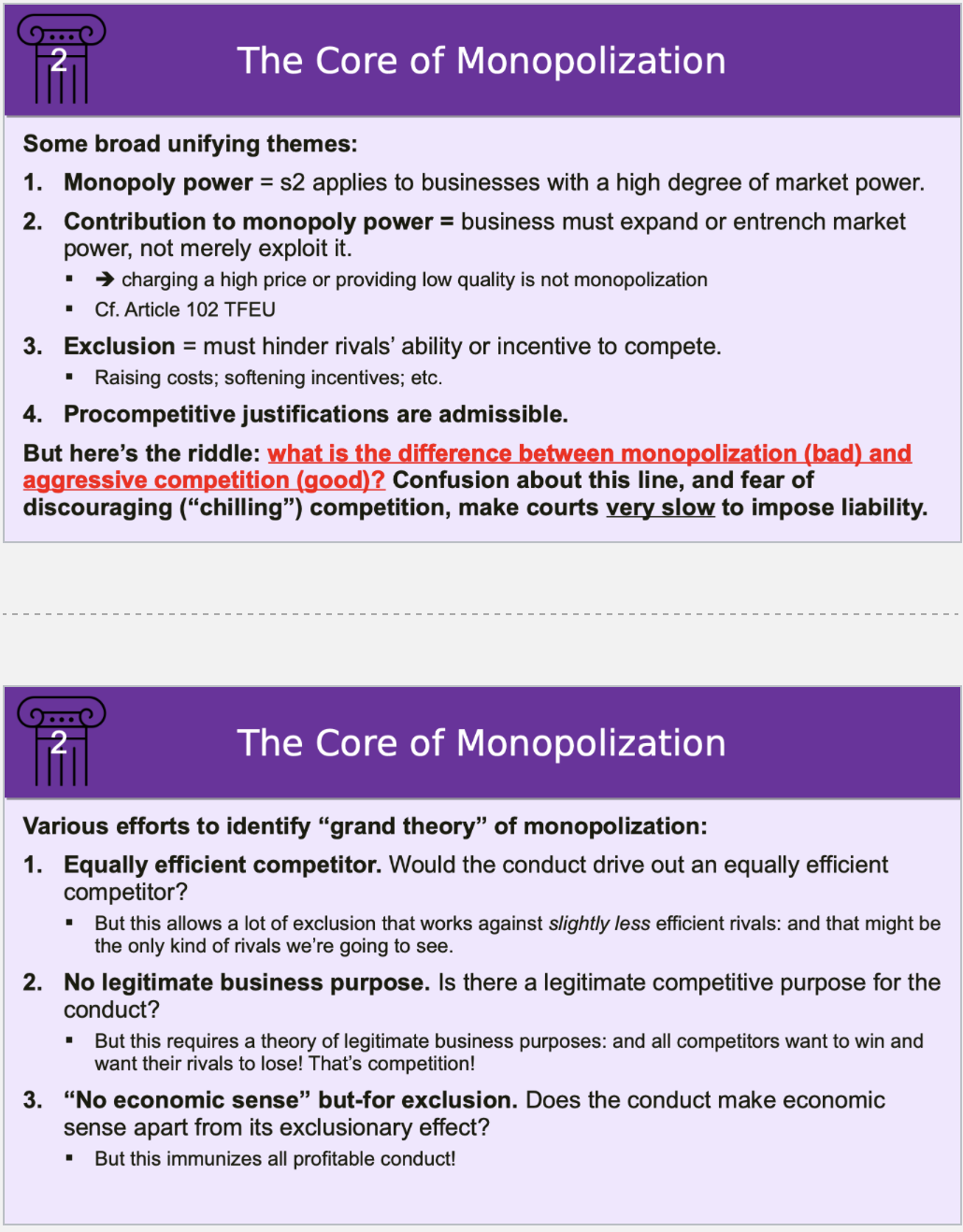
Specific kinds of Monopolization
Exclusivity
Tying
Predatory Pricing
Bundling
Refusal to deal
Others
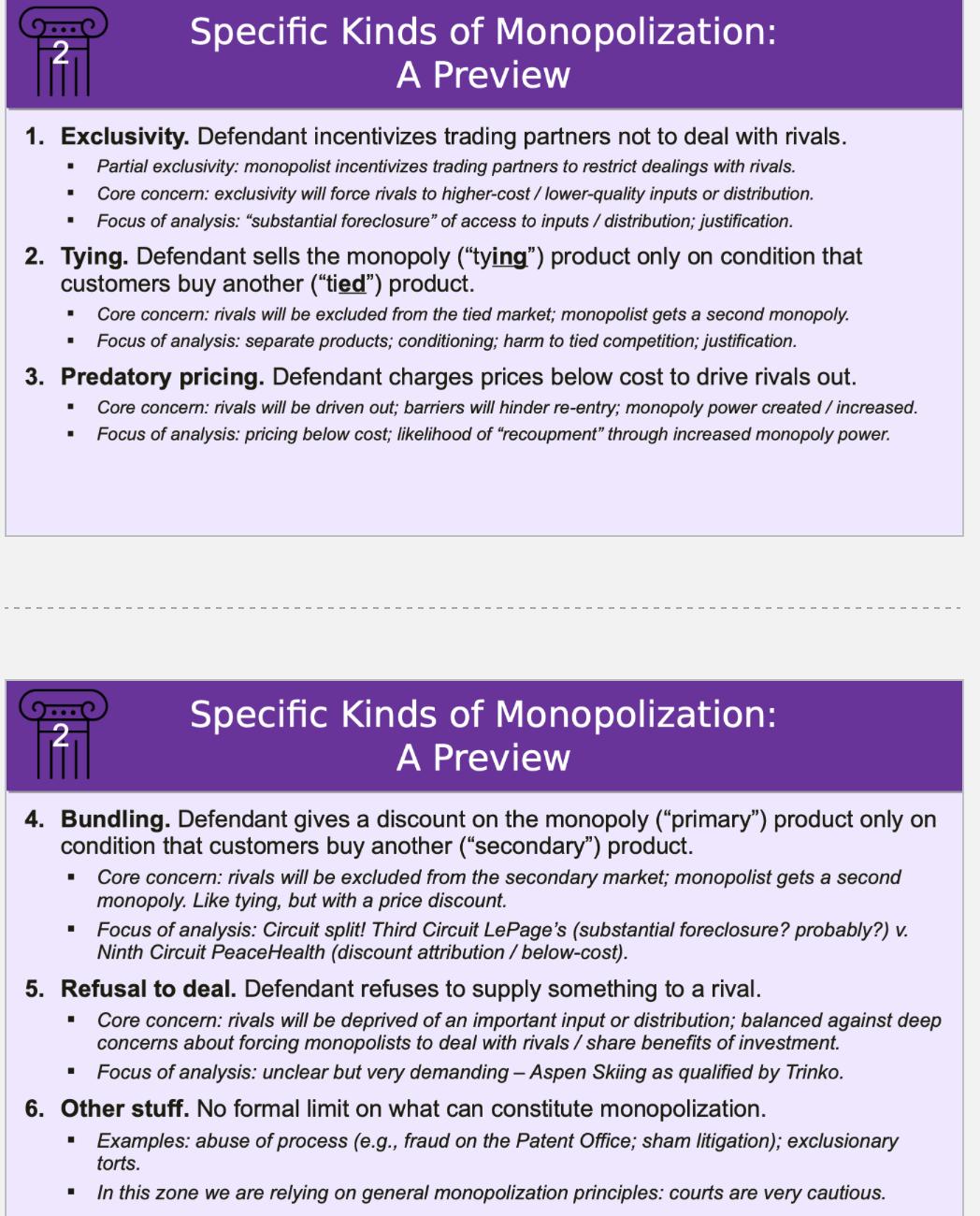
Dentsply
Exclusion
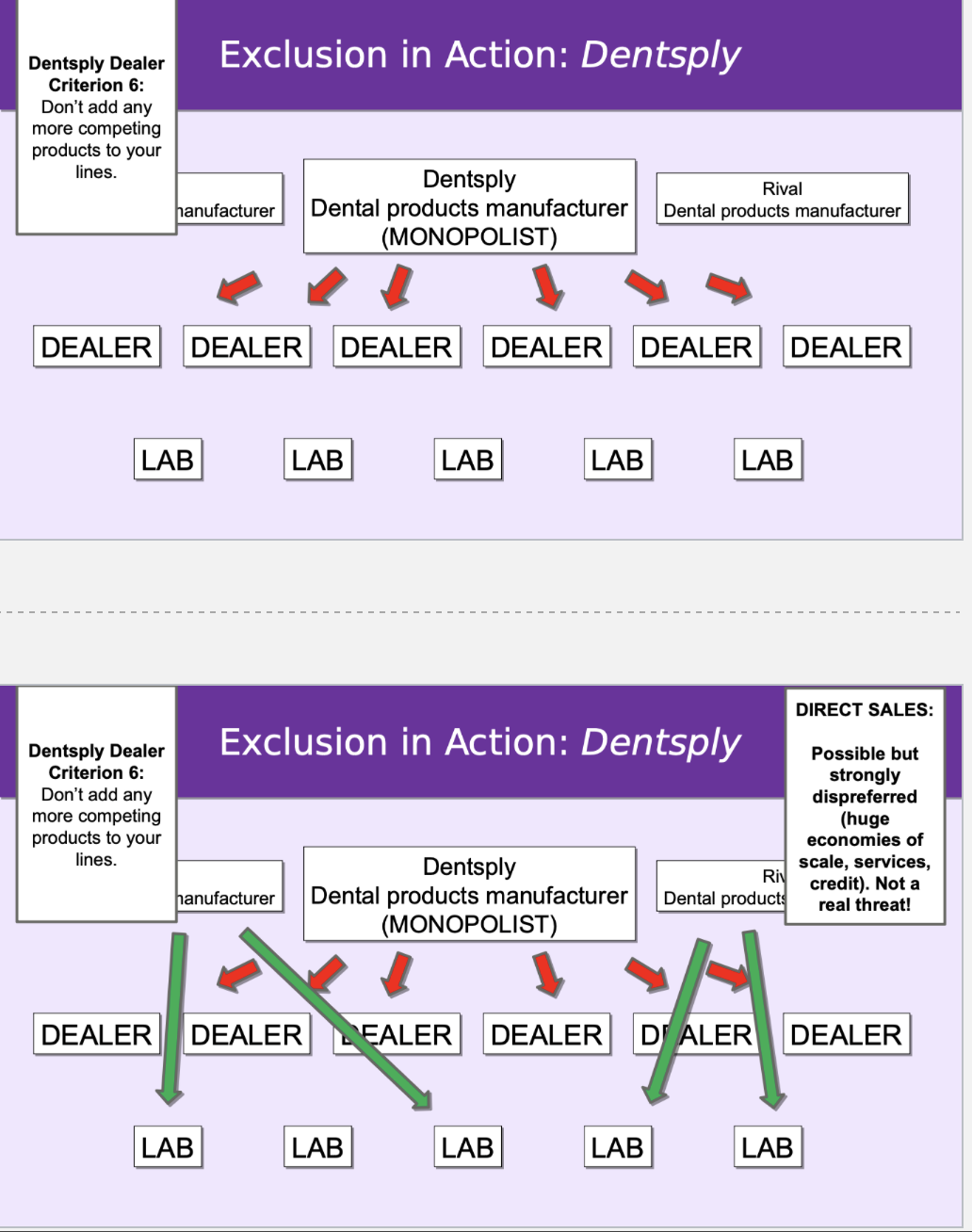
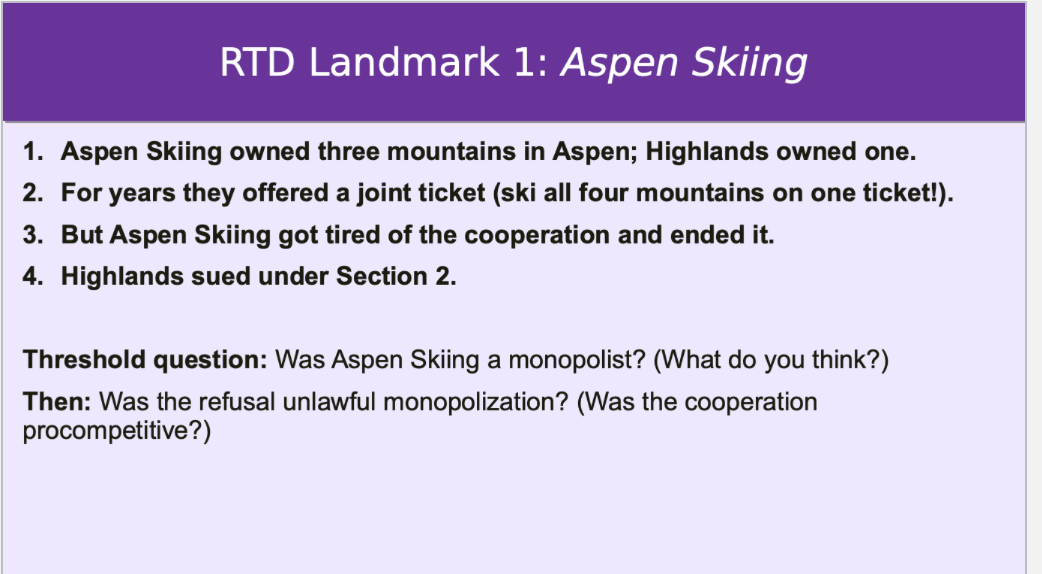
Aspen Skiing v Aspen Highlands
Refusal to deal
Tests: unnecessarily restrictive. Attempting to exclude rivals on some basis other than efficiency
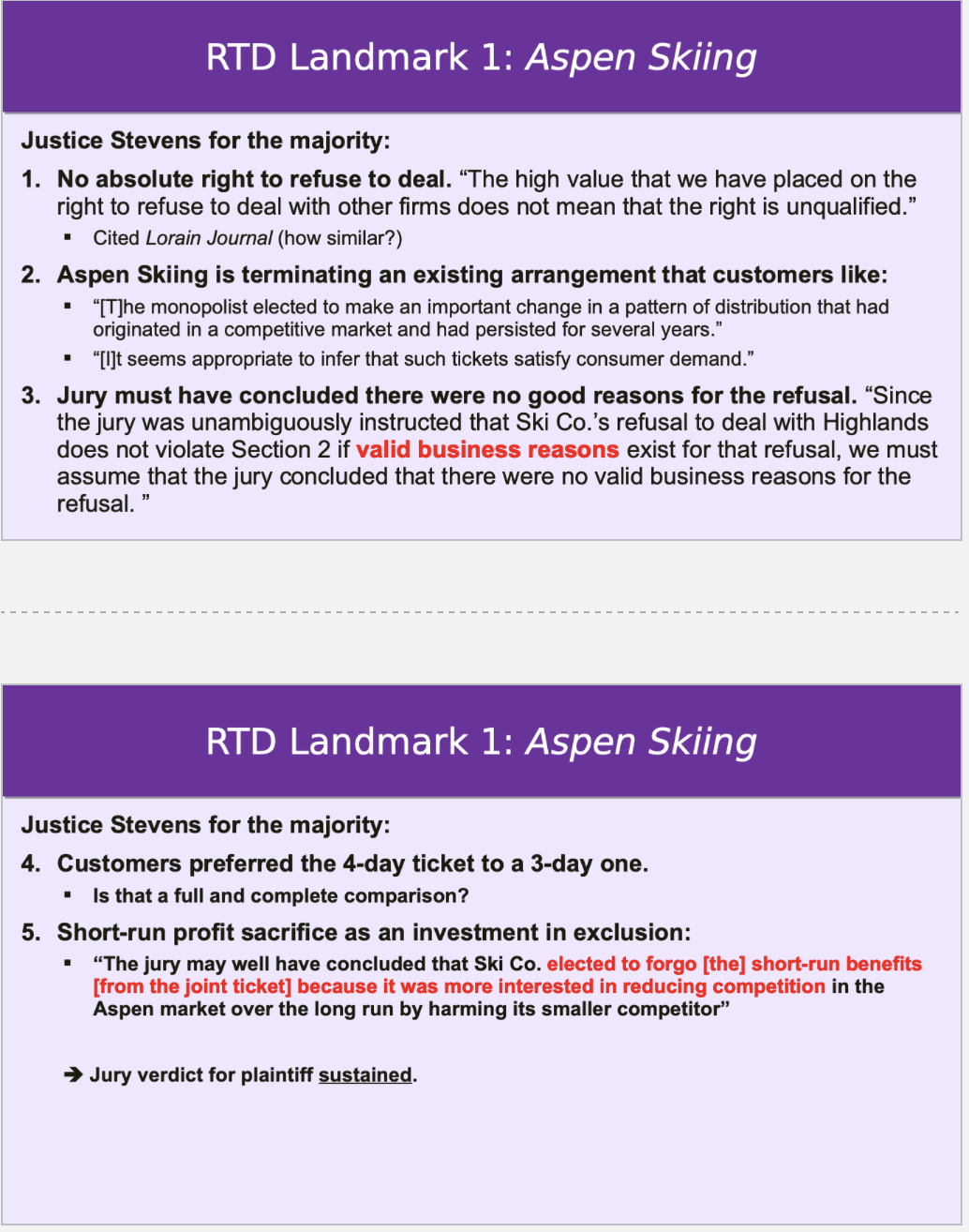
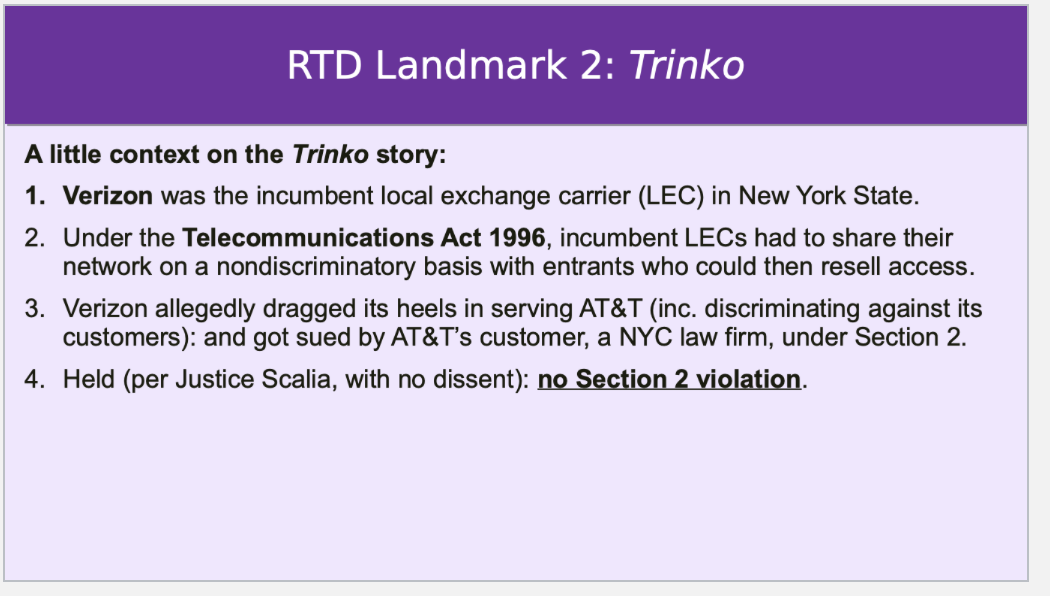
Trinko
Held: Aspen Skiing is “at or near the outer boundary” of s2 & doesn’t apply here.
1. The Aspen case involved profit sacrifice through termination of a previous
profitable course of dealing. “The unilateral termination of a voluntary (and thus
presumably profitable) course of dealing suggested a willingness to forsake short-
term profits to achieve an anticompetitive end.”
2. Aspen refused to share even if paid retail price. “Similarly, the defendant’s
unwillingness to renew the ticket even if compensated at retail price revealed a
distinctly anticompetitive bent.”
3. Aspen was already supplying the product. Here, Verizon wouldn’t be supplying
unbundled access at all if it weren’t for the Telecommunication Act 1996.
4. Access is federally regulated here! Reduces benefits of antitrust intervention.
Trinko is an iconic and influential statement of caution in Section 2 law.
1. Error costs of wrongful liability. “Mistaken inferences and the resulting false
condemnations are especially costly, because they chill the very conduct the
antitrust laws are designed to protect. The cost of false positives counsels against
an undue expansion of § 2 liability.”
2. Every dispute could turn into antitrust litigation. Too much intervention would
“distort investment and lead to a new layer of interminable litigation, atop the
variety of litigation routes already available to and actively pursued by [rivals].”
3. Micromanaging prices and terms could be too much for a court. “No court
should impose a duty to deal that it cannot explain or adequately and reasonably
supervise. The problem should be deemed irremediable . . . [when it requires] the
court to assume the day-to-day controls characteristic of a regulatory agency
Bottom line:
1. Trinko symbolizes caution about Section 2 (esp. forced sharing).
2. Aspen Skiing now widely regarded as confined to its facts: termination of a
previous voluntary and profitable course of dealing, in something the
defendant voluntarily supplies, for purely anticompetitive purposes.
3. But:
a. Why punish termination of existing dealings more strictly than new refusals?
b. Is it “anticompetitive” not to want to subsidize your rival? Is it “exclusion” at all?
c. The Trinko Court at least considered whether to expand s2 beyond Aspen: was
the federal regulation the reason it didn’t do so?
d. Why is a “profit sacrifice” suspicious?
Some monopolization is short-run profitable; some profit sacrifice is procompetiti
Monopoly is not unlawful: in
fact it serves a useful function!
“The opportunity to charge
monopoly prices at least for a
short period is what attracts
‘business acumen’ in the first
place; it induces risk taking that
produces innovation and
growth.”